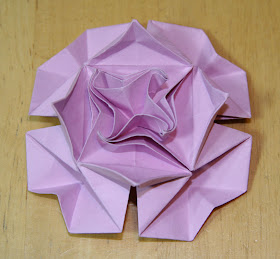
Perhaps you are familiar with the traditional Fragrant Blossom Kusudama, one of the most beautiful of the Japanese Flower Balls. Here is a photo of one made by Mio Tsugawa. You will find it on her blog, together with instructions for making it.
http://puupuu.ojaru.jp/zu/densyo/densyo1.html
It has long bothered me that this model, and others like it, use glue. Glue is just not a word generally associated with origami!
So I decided to design a model which did not use glue. Here is the copy paper version.

It has three different parts: two from a square and one (the central core) from a hexagon with the same diameter as the square sheets.
The peach colored material is a square which is folded almost identically to the traditional Fragrance model. The difference is that the peaks on either side are not folded down before the sides are folded over and brought together. When the sides are brought together these peaks are tucked into the pockets on the sides of the sections. One peak is folded into the medial (inside) pocket of its opposite partner. The other peak is then folded into the lateral (outside) pocket of its partner. The central section is now one, instead of three, sections but the petal stays together without glue. (You cannot see this in the photos because it is covered by material from the next piece).

The salmon colored material is made from another square which also begins its folded life by becoming a triangle. The central half is folded over and tucked into itself, in a similar fashion to what happened with the central sections of the petal. One of the side flaps is then posted through the slit in the front of a peach colored petal and wrapped around to the side of the stamen. Its tip is then pushed into the pocket at the top, which it now shares with the flap from the adjoining peach colored petal stamen. The other side flap of the salmon piece is inserted in similar fashion into the neighboring (next) petal. This leaves a triangular salmon colored section between the petals which, from the top of the flower, looks like another stamen.
Continue to add petals and connectors until the flower is complete. The resulting flower works best with six petals. Five seems a little loose.

The hexagonal cream center of the flower is formed from a hexagonal sheet. Once the central hexagon has been formed the rest of the sheet is carefully arranged into a tightly creased column and inserted into the center of the completed flower. The ridges of the hexagon column are held by corresponding ridges formed by the flower petals and their salmon colored connectors. A diagram would help, but it is more work than I feel like doing right now. Later, maybe.
I would rate this as a high intermediate model. It is not difficult to fold but it is tricky to put together. It requires helping instruments (I used a kitchen skewer) to push the flaps into the pockets. It is hard to keep the single thickness petal edges from being damaged by the tucking process happening in their vicinity. It needs patience to neatly arrange the folds of the stem of the central hexagon core.
Diagramming this model will not be easy and I suspect that I will restrict myself to teaching it in a class.
My next task is to create glueless connectors for the bases of the flowers so that the model can be transformed into a "proper origami" kusudama. This is complicated by the fact that my version of the flowers have six, rather than five petals. Six sided objects do not make a regular polyhedra without the addition of differently sided objects. I may have to find a way to modify the flower into a five petal version.








